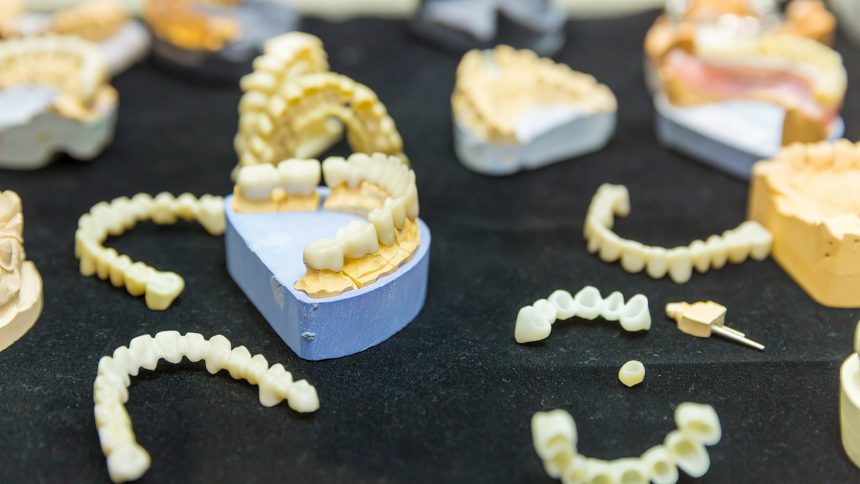A removable bridge, more commonly known as a denture, is a removable replacement for missing teeth and adjacent tissues. It is made of acrylic resin, sometimes in combination with various metals. Types of Dentures Complete dentures replace all the teeth, while a partial denture fills in the spaces created by missing teeth and prevents other teeth from changing position. Candidates for complete dentures have lost most or all of their teeth. A partial denture is suitable for those who have some natural teeth remaining. A denture improves chewing ability and speech, and provides support for facial muscles. It will greatly...

Non-Surgical Periodontal Therapy
Non-surgical therapy removes plaque and calculus by controlling the growth of harmful bacteria and by treating conditions that encourage gum disease. This type of treatment may be all that’s needed, especially when periodontal disease is caught early. You may also need to have certain procedures, such as replacing worn fillings or crowns with overhanging margins that can accumulate plaque, taken care of before periodontal therapy can begin. Scaling and Root Planing Scaling is a type of cleaning that removes plaque and calculus from the teeth at and slightly below the gumline. Root planing smooths root surfaces, so the supportive tissues...

Soft Tissue Grafts
Periodontal procedures are available to stop further dental problems and gum recession, and/or to improve the esthetics of your gum line. Exposed tooth roots are the result of gum recession. Perhaps you wish to enhance your smile by covering one or more of these roots that make your teeth appear too long. Or, maybe you’re not bothered by the appearance of these areas, but you cringe because the exposed roots are sensitive to hot or cold foods and liquids. Your gums may have receded for a variety of reasons, including aggressive tooth brushing or periodontal disease. You may not be...

Crown Lengthening
Periodontal procedures are available to lay the groundwork for restorative and cosmetic dentistry and/or to improve the esthetics of your gum line. You may have asked your periodontist about procedures to improve a “gummy” smile because your teeth appear short. Your teeth may actually be the proper lengths, but they’re covered with too much gum tissue. To correct this, your periodontist performs crown lengthening. During this procedure, excess gum and bone tissue is reshaped to expose more of the natural tooth. This can be done to one tooth, to even your gum line, or to several teeth to expose a...

Periodontal Surgery
If you’re diagnosed with periodontal disease, your periodontist may recommend periodontal surgery. Periodontal surgery is necessary when your periodontist determines that the tissue around your teeth is unhealthy and cannot be repaired with non-surgical treatment. Pocket Depth Reduction When supporting tissue and bone is destroyed, “pockets” form around the teeth. Your bone and gum tissue should fit snugly around your teeth like a turtleneck around your neck. When you have periodontal disease, this supporting tissue and bone is destroyed, forming “pockets” around the teeth. Over time, these pockets become deeper, providing a larger space for bacteria to live. As bacteria...

Non-Surgical Dental Treatments
Periodontal treatment guidelines stress that periodontal health should be achieved in the least invasive and most cost-effective manner. This is often accomplished through non-surgical periodontal treatment, including scaling and root planing (a careful cleaning of the root surfaces to remove plaque and calculus [tartar] from deep periodontal pockets and to smooth the tooth root to remove bacterial toxins), followed by adjunctive therapy such as local delivery antimicrobials and host modulation, as needed on a case-by-case basis. Most periodontists would agree that after scaling and root planing, many patients do not require any further active treatment, including surgical therapy. However, the...

Dental Crowns and Caps
As far as a dental restoration goes, crowns and caps are used synonymously. Crowns are synthetic caps, usually made of a material like porcelain, placed on the top of a tooth. Crowns are typically used to restore a tooth’s function and appearance following a restorative procedure such as a root canal. When decay in a tooth has become so advanced that large portions of the tooth must be removed, crowns are often used to restore the tooth. Crowns are also used to attach bridges, cover implants, prevent a cracked tooth from becoming worse, or an existing filling is in jeopardy...

Root Canal Therapy
The pulp, or soft inner tissue is important during the tooth’s development. Once a tooth is fully mature, the tooth can survive without the pulp because the tooth is nourished by tissues surrounding it. The pulp is normally surrounded and protected by a layer of dentin. Above the gumline, the dentin is protected by a layer of enamel; below the gum-line the dentin is covered by cementum. When a crack or cavity destroys these protective layers, the pulp is exposed to irritants and bacteria in your mouth. This can result in inflammation then infection, and, eventually, an abscess. Periodontal (gum)...

Composite Fillings
Composite fillings are a mixture of glass or quartz filler in a resin medium that produces a tooth-colored filling. They are sometimes referred to as composites or filled resins. Composite fillings provide good durability and resistance to fracture in small-to-mid size restorations that need to withstand moderate chewing pressure. Less tooth structure is removed when the dentist prepares the tooth, and this may result in a smaller filling than that of an amalgam. Composites can also be “bonded” or adhesively held in a cavity, often allowing the dentist to make a more conservative repair to the tooth. The cost is...

Amalgam Fillings
Used by dentists for more than a century, dental amalgam is the most thoroughly researched and tested restorative material among all those in use. It is durable, easy to use, highly resistant to wear and relatively inexpensive in comparison to other materials. For those reasons, it remains a valued treatment option for dentists and their patients. Dental amalgam is a stable alloy made by combining elemental mercury, silver, tin, copper and possibly other metallic elements. Although dental amalgam continues to be a safe, commonly used restorative material, some concern has been raised because of its mercury content. However, the mercury...


